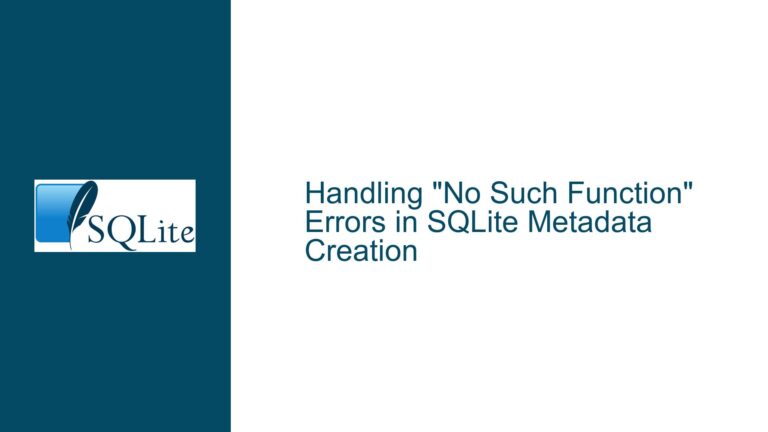Generated Columns in STRICT Tables Yield Unexpected Fractional Results
Understanding the Behavior of Generated Columns in STRICT Tables
The core issue revolves around the unexpected behavior of generated columns within STRICT tables in SQLite. Specifically, when a generated column is defined as INTEGER and involves a division operation, the result may yield a fractional value despite the column being explicitly typed as INTEGER. This behavior contradicts the expectations set by the SQL standard and the documented behavior of STRICT tables, which mandate that values must be losslessly convertible to the specified datatype.
To illustrate, consider the following table definition:
CREATE TABLE t (
b INTEGER,
x INTEGER GENERATED ALWAYS AS (b/10.0) STORED
) STRICT;
When inserting a value into column b, the generated column x is expected to store an integer value. However, the result of the division operation b/10.0 yields a fractional value, which is then stored in the INTEGER column x. This behavior is unexpected because STRICT tables are designed to enforce strict type constraints, ensuring that only values of the specified type (or NULL) are stored.
The issue is further highlighted by the PRAGMA quick_check output, which flags the presence of a non-INTEGER value in the x column:
PRAGMA main.quick_check(t);
non-INTEGER value in t.x
This output confirms that the generated column x contains a value that does not conform to the INTEGER type constraint, raising questions about the interaction between generated columns and STRICT tables.
Exploring the Root Causes of the Unexpected Behavior
The unexpected behavior of generated columns in STRICT tables can be attributed to several factors, including the handling of type conversions, the evaluation of generated expressions, and the enforcement of type constraints in STRICT tables.
First, the evaluation of the generated expression b/10.0 involves a division operation that inherently produces a floating-point result. In SQLite, division operations involving integers and floating-point numbers typically yield floating-point results, even when the operands are integers. This behavior is consistent with SQLite’s type affinity system, which allows for flexible type conversions. However, in the context of STRICT tables, this behavior becomes problematic because the result of the division operation is expected to be an integer.
Second, the enforcement of type constraints in STRICT tables is designed to ensure that only values of the specified type (or NULL) are stored. When a value is inserted into a STRICT table, SQLite performs a type check to verify that the value can be losslessly converted to the specified datatype. If the value cannot be converted without loss of precision, an SQLITE_CONSTRAINT_DATATYPE error is raised. However, in the case of generated columns, this type check appears to be bypassed or not fully enforced, allowing fractional values to be stored in INTEGER columns.
Third, the interaction between generated columns and STRICT tables may involve subtle differences in how type conversions are handled during expression evaluation versus value insertion. While the SQL standard and other databases like PostgreSQL may enforce stricter type constraints during expression evaluation, SQLite’s type affinity system may allow for more lenient conversions, leading to unexpected results.
Resolving the Issue: Steps, Solutions, and Fixes
To address the issue of generated columns yielding unexpected fractional results in STRICT tables, several steps can be taken to ensure that the behavior aligns with expectations and the documented behavior of STRICT tables.
Step 1: Explicit Type Casting in Generated Expressions
One approach to resolving the issue is to explicitly cast the result of the generated expression to the desired datatype. In the case of the x column, the expression b/10.0 can be modified to include an explicit cast to INTEGER:
CREATE TABLE t (
b INTEGER,
x INTEGER GENERATED ALWAYS AS (CAST(b/10.0 AS INTEGER)) STORED
) STRICT;
By adding the CAST function, the result of the division operation is explicitly converted to an INTEGER, ensuring that the generated column x contains only integer values. This approach aligns with the behavior expected from STRICT tables and prevents the storage of fractional values in INTEGER columns.
Step 2: Adjusting the Generated Expression to Avoid Fractional Results
Another approach is to adjust the generated expression to avoid producing fractional results in the first place. For example, if the goal is to store the result of dividing b by 10 as an integer, the expression can be modified to use integer division:
CREATE TABLE t (
b INTEGER,
x INTEGER GENERATED ALWAYS AS (b/10) STORED
) STRICT;
In this case, the division operation b/10 performs integer division, which inherently produces an integer result. This approach eliminates the need for explicit type casting and ensures that the generated column x contains only integer values.
Step 3: Reviewing and Updating Documentation
Given the unexpected behavior of generated columns in STRICT tables, it is important to review and update the SQLite documentation to clarify the interaction between these features. The documentation should explicitly state that generated columns in STRICT tables are subject to the same type constraints as regular columns and that expressions used in generated columns must produce values that are losslessly convertible to the specified datatype. Additionally, the documentation should provide examples of how to handle type conversions in generated expressions to avoid unexpected results.
Step 4: Reporting and Addressing Potential Bugs
If the behavior of generated columns in STRICT tables is deemed to be a bug, it should be reported to the SQLite development team for further investigation and resolution. The issue can be reported through the SQLite forum or the official SQLite bug tracking system. When reporting the issue, it is important to provide a detailed description of the problem, including the table definition, the generated expression, and the observed behavior. Additionally, it is helpful to include a comparison with the behavior of other databases, such as PostgreSQL, to highlight the discrepancy.
Step 5: Implementing Workarounds in Application Code
In cases where the issue cannot be resolved through changes to the table definition or generated expressions, workarounds can be implemented in the application code. For example, the application can perform additional validation checks on the values stored in generated columns to ensure that they conform to the expected datatype. Alternatively, the application can use triggers to enforce type constraints on generated columns, ensuring that only values of the specified type are stored.
Step 6: Testing and Validation
After implementing any of the above solutions, it is important to thoroughly test and validate the behavior of the generated columns in STRICT tables. This includes testing various scenarios, such as inserting different values into the b column and verifying that the generated column x contains the expected integer values. Additionally, it is important to test edge cases, such as inserting NULL values or values that may result in division by zero, to ensure that the table behaves as expected in all scenarios.
Step 7: Monitoring for Future Updates
Finally, it is important to monitor future updates to SQLite for any changes or fixes related to the behavior of generated columns in STRICT tables. The SQLite development team may release updates that address the issue or provide additional features for handling type conversions in generated expressions. By staying informed about these updates, you can ensure that your database schema and application code remain aligned with the latest best practices and features in SQLite.
In conclusion, the issue of generated columns yielding unexpected fractional results in STRICT tables can be resolved through a combination of explicit type casting, adjusting generated expressions, updating documentation, reporting potential bugs, implementing workarounds in application code, thorough testing, and monitoring for future updates. By following these steps, you can ensure that your database schema and application code adhere to the expected behavior of STRICT tables and avoid unexpected results in generated columns.






